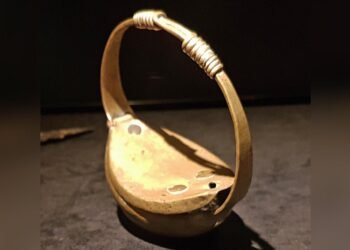Archaeologists have unearthed the remnants of a 2,000-year-old Roman sandal near an ancient military fort in Oberstimm, Bavaria. The discovery was made by a team from the Bavarian State Office for Monument Preservation (BLfD) during an excavation of a civilian settlement adjacent to a Roman military fort that dates back to between 60 and 130 CE.

The artifact, initially mistaken for a sickle due to its corroded state, was later identified using X-ray imaging as a well-preserved sole of a caliga, a type of hobnailed sandal worn by Roman soldiers. These sandals, fitted with iron nails for traction, were essential for soldiers traversing rough terrains, much like modern cleats.
Amira Adaileh, a consultant at the BLfD, explained the significance of the find: “So-called caligae were mainly worn by Roman soldiers during the Roman Empire. The discovery illustrates that the practices, lifestyles, and even the clothing that the Romans brought to Bavaria were adopted by the local people.”
This specific caliga, found at the bottom of a well, is remarkably well-preserved compared to typical finds of shoe nails scattered across various sites. The preservation is likely due to the unique conditions at the bottom of the well. Comparable finds are rare, with similar discoveries in Bavaria limited to only a handful of sites.

Mathias Pfeil, general conservator at the BLfD, emphasized the importance of such discoveries: “Surprise finds like the shoe sole from Oberstimm repeatedly demonstrate that valuable information is still gathered even after the completion of archaeological excavations.”
The caliga, characterized by its iron nails, was designed to prevent blisters and other foot conditions such as trench foot, which were common ailments for soldiers on long marches. The sandal’s design provided stability and grip, crucial for the harsh and varied terrains Roman soldiers often encountered.
The settlement where the sandal was found is situated near a Roman military fort and contains various other artifacts, including typical Roman ceramics like Terra Sigillata, food scraps, tools, and costume components.

The Roman Empire, which lasted from 27 BCE to 476 CE, saw a gradual shift in military footwear from the open-toed caligae to the more enclosed calcei by the end of the first century CE. This transition was motivated by the need for greater warmth and protection for soldiers. The discovery of the caliga in Oberstimm, however, indicates that elements of Roman footwear persisted in the region longer than previously thought.
This discovery also highlights the diffusion of Roman cultural practices and attire into local Bavarian populations. “The practices, lifestyles, and clothing that the Romans brought to Bavaria were adopted by the local people,” Adaileh said.
The BLfD continues to analyze the findings from Oberstimm, with the hope of uncovering more about the interaction between Roman soldiers and local populations.






















